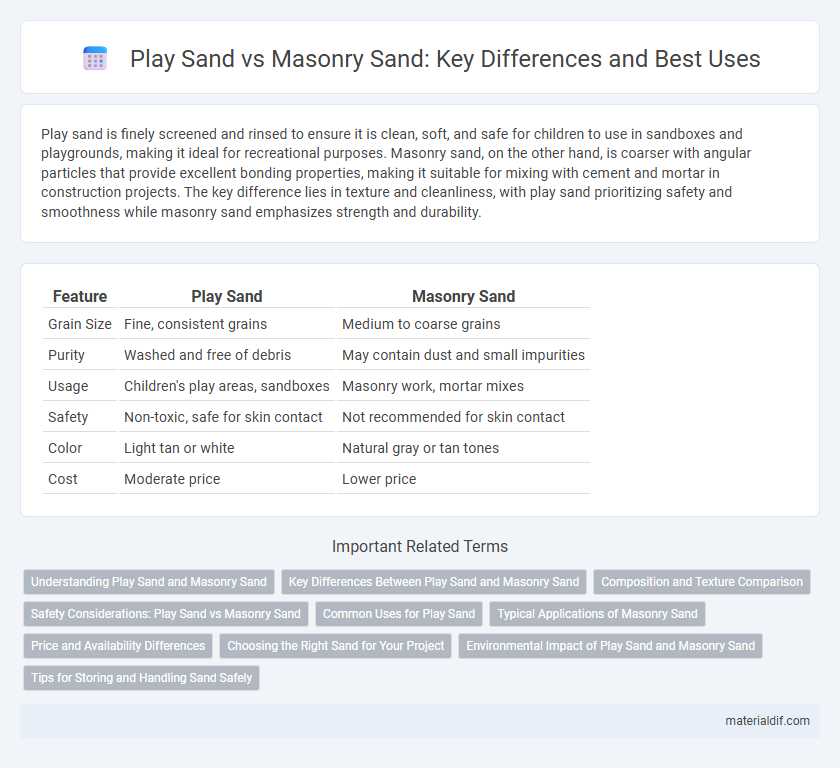Play sand is finely screened and rinsed to ensure it is clean, soft, and safe for children to use in sandboxes and playgrounds, making it ideal for recreational purposes. Masonry sand, on the other hand, is coarser with angular particles that provide excellent bonding properties, making it suitable for mixing with cement and mortar in construction projects. The key difference lies in texture and cleanliness, with play sand prioritizing safety and smoothness while masonry sand emphasizes strength and durability.
Table of Comparison
| Feature | Play Sand | Masonry Sand |
|---|---|---|
| Grain Size | Fine, consistent grains | Medium to coarse grains |
| Purity | Washed and free of debris | May contain dust and small impurities |
| Usage | Children's play areas, sandboxes | Masonry work, mortar mixes |
| Safety | Non-toxic, safe for skin contact | Not recommended for skin contact |
| Color | Light tan or white | Natural gray or tan tones |
| Cost | Moderate price | Lower price |
Understanding Play Sand and Masonry Sand
Play sand typically features fine, smooth grains that are safe for children's sensory activities and outdoor play areas, offering non-toxic and dust-free qualities. Masonry sand contains coarser, angular particles designed to improve the bonding strength in mortar mixes for bricklaying and other construction tasks. Understanding these differences helps select the right sand type based on texture, safety, and structural requirements.
Key Differences Between Play Sand and Masonry Sand
Play sand is finely graded, naturally colored, and designed to be safe for children, making it ideal for playgrounds and sandboxes, while masonry sand is coarser with sharp edges, used primarily in construction for mixing concrete and mortar. The key difference lies in texture and composition: play sand is soft and uniform to prevent injury, whereas masonry sand provides better grip and bonding in building applications. Both types vary in cleanliness and particle size, with play sand often washed and sterilized, and masonry sand being less processed.
Composition and Texture Comparison
Play sand primarily consists of fine-grained silica particles with a smooth texture, ideal for safe use in children's play areas due to its uniformity and cleanliness. Masonry sand contains a mix of coarse and fine grains, including quartz, feldspar, and mica, giving it a rougher texture suitable for construction purposes like mortar and concrete. The fine, consistent texture of play sand contrasts with the granular, varied composition of masonry sand, affecting their respective applications in playgrounds and building projects.
Safety Considerations: Play Sand vs Masonry Sand
Play sand is specifically manufactured to be non-toxic and free of harmful contaminants, making it safe for children's use in sandboxes and playgrounds. Masonry sand, while clean and fine-grained, may contain silica particles that pose inhalation risks and are not recommended for direct contact with skin or ingestion. Choosing play sand reduces exposure to potential respiratory hazards and ensures a safer environment for children's activities.
Common Uses for Play Sand
Play sand is primarily used in children's sandboxes, playgrounds, and sensory play areas, offering a soft, fine texture that is safe and non-toxic for tactile and creative activities. Unlike masonry sand, which is coarser and commonly used in construction for mixing concrete and mortar, play sand provides an ideal consistency for digging, molding, and building sandcastles. Its clean, dust-free composition ensures minimal health risks, making it suitable for indoor and outdoor recreational environments.
Typical Applications of Masonry Sand
Masonry sand is primarily used for creating smooth and durable mortar mixes ideal for bricklaying and block work. Its fine texture and clean composition make it suitable for plastering, pointing, and repairing concrete surfaces where a consistent finish is essential. Unlike play sand, masonry sand provides the necessary strength and binding properties required for structural applications.
Price and Availability Differences
Play sand generally costs less than masonry sand, making it a budget-friendly option for recreational use and light projects. Masonry sand is often more expensive due to its finer grain size and higher standards for clean, uniform material, suitable for concrete and mortar mixes. Availability varies by region, with play sand commonly stocked in home improvement stores while masonry sand is typically found at construction supply yards.
Choosing the Right Sand for Your Project
Play sand features fine grains and low dust content, ideal for children's sandboxes and recreational activities due to its safety and cleanliness. Masonry sand contains coarser particles and is specifically formulated for construction purposes, such as mixing with cement for mortar or concrete, providing strength and durability. Selecting the right sand depends on the project's requirements: choose play sand for safe, clean play areas and masonry sand for robust building applications.
Environmental Impact of Play Sand and Masonry Sand
Play sand typically has a lower environmental impact due to its natural, non-toxic composition and minimal processing, making it safer for ecosystems and human health. Masonry sand, often sourced from construction sites, may involve more extensive quarrying and processing, leading to higher energy consumption and greater habitat disruption. Both types of sand require responsible sourcing and management to mitigate environmental degradation and promote sustainable use.
Tips for Storing and Handling Sand Safely
Play sand should be stored in moisture-resistant containers to prevent clumping, while masonry sand requires dry, covered storage to maintain its coarse texture. Use protective gloves and masks when handling either type of sand to avoid skin irritation and inhalation of fine particles. Ensure sand is kept off the ground by using pallets or raised platforms to reduce contamination and facilitate drying.
Play Sand vs Masonry Sand Infographic

 materialdif.com
materialdif.com